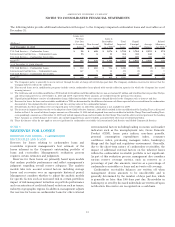American Express 2010 Annual Report Download - page 80
Download and view the complete annual report
Please find page 80 of the 2010 American Express annual report below. You can navigate through the pages in the report by either clicking on the pages listed below, or by using the keyword search tool below to find specific information within the annual report.
The following table discloses the estimated fair value for the
Company’s financial assets and financial liabilities that are not
carried at fair value, as of December 31:
(Billions)
Carrying
Value
Fair
Value
Carrying
Value
Fair
Value
2010 2009
Financial Assets:
Assets for which carrying values
equal or approximate fair value $62$62
(a)
$58$58
(b)
Loans, net $58$58
(a)
$30$30
Financial Liabilities:
Liabilities for which carrying
values equal or approximate
fair value $43$43$34$34
Certificates of deposit $13$13$15$16
Long-term debt $66$69
(a)
$52$54
(b)
(a) Includes fair values of cardmember receivables, loans and long-term debt of
$8.1 billion, $33.2 billion and $23.6 billion, respectively, held by consolidated
VIEs as of December 31, 2010. Refer to the Consolidated Balance Sheets for
the related carrying values.
(b) Includes fair values of cardmember receivables and long-term debt of
$8.3 billion and $5.0 billion, respectively, held by a consolidated VIE as
of December 31, 2009. Refer to the Consolidated Balance Sheets for the
related carrying values.
The fair values of these financial instruments are estimates
based upon the market conditions and perceived risks as of
December 31, 2010 and 2009, and require management
judgment. These figures may not be indicative of their future
fair values. The fair value of the Company cannot be reliably
estimated by aggregating the amounts presented.
The following methods were used to determine estimated
fair values:
FINANCIAL ASSETS FOR WHICH CARRYING VALUES
EQUAL OR APPROXIMATE FAIR VALUE
Financial assets for which carrying values equal or approximate
fair value include cash and cash equivalents, cardmember
receivables, accrued interest and certain other assets. For
these assets, the carrying values approximate fair value
because they are short term in duration or variable rate
in nature.
FINANCIAL ASSETS CARRIED AT OTHER THAN
FAIR VALUE
Loans, net
Loans are recorded at historical cost, less reserves, on the
Consolidated Balance Sheets. In estimating the fair value for
the Company’s loans the principal market is assumed to be the
securitization market, and the Company uses the hypothetical
securitization price to determine the fair value of the portfolio.
The securitization price is estimated from the assumed proceeds
of the hypothetical securitization in the current market, adjusted
for securitization uncertainties such as market conditions
and liquidity.
FINANCIAL LIABILITIES FOR WHICH CARRYING
VALUES EQUAL OR APPROXIMATE FAIR VALUE
Financial liabilities for which carrying values equal or
approximate fair value include accrued interest, customer
deposits (excluding certificates of deposit, which are described
further below), Travelers Cheques outstanding, short-term
borrowings and certain other liabilities for which the carrying
values approximate fair value because they are short term in
duration, variable rate in nature or have no defined maturity.
FINANCIAL LIABILITIES CARRIED AT OTHER THAN
FAIR VALUE
Certificates of Deposit
Certificates of deposit (CDs) are recorded at their historical
issuance cost on the Consolidated Balance Sheets. Fair value is
estimated using a discounted cash flow methodology based on
the Company’s current borrowing rates for similar types of CDs.
Long-term Debt
Long-term debt is recorded at historical issuance cost on the
Consolidated Balance Sheets. Fair value is estimated using
either quoted market prices or discounted cash flows based
on the Company’s current borrowing rates for similar types
of borrowings.
NOTE 4
ACCOUNTS RECEIVABLE AND LOANS
The Company’s charge and lending payment card products
result in the generation of cardmember receivables (from
charge payment products) and cardmember loans (from
lending payment products) which are described below.
CARDMEMBER AND OTHER RECEIVABLES
Cardmember receivables, representing amounts due from
charge payment product customers, are recorded at the time
a cardmember enters into a point-of-sale transaction with a
merchant. Charge card customers generally must pay the full
amount billed each month. Each charge card transaction is
authorized based on its likely economics reflecting
cardmember’s most recent credit information and spend
patterns. Global limits are established to limit maximum
exposure for high risk and some high spend charge
cardmembers. Accounts of high risk, out-of-pattern charge
cardmembers can be monitored even if they are current.
Cardmember receivable balances are presented on the
Consolidated Balance Sheets net of reserves for losses (refer
to Note 5), and include principal and any related accrued fees.
78
AMERICAN EXPRESS COMPANY
NOTES TO CONSOLIDATED FINANCIAL STATEMENTS
























